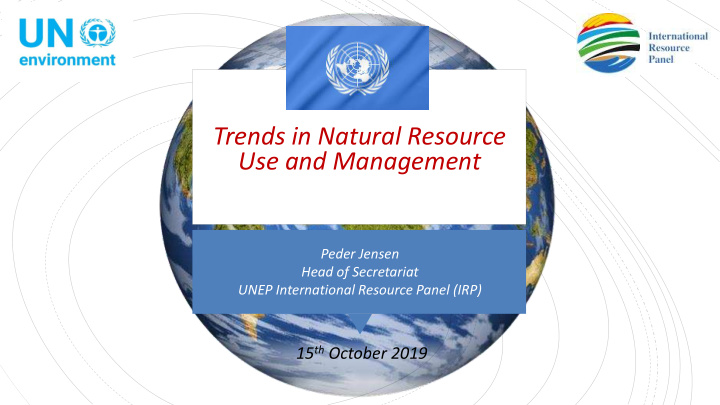



Trends in Natural Resource Use and Management Peder Jensen Head of Secretariat UNEP International Resource Panel (IRP) 15 th October 2019
Who are we? The International Resource Panel Climate Change – IRP was launched in 2007 with the idea of creating a science- IPBES policy interface on the sustainable Biodiversity Loss use of natural resources and in particular their environmental Resource Efficiency impacts over the full life cycle
NATURAL RESOURCES FOR THE FUTURE WE WANT
Resources: provide the foundation for the goods, services and infrastructure that make up our current socio-economic systems Biomass (wood, crops, including food, fuel, Fossil fuels (coal, gas feedstock and plant- and oil) based materials) Non-metallic minerals Metals (such as iron, (including sand, gravel aluminum and cooper…) and limestone) UN International Resource Panel
Relentless demand: Global resource use, Material demand per capita and Material productivity • Global resource use has more than tripled since 1970 • Global material demand per capita grew from 7.4 tons in 1970 to 12.2 tons per capita in 2017 • Material productivity started to decline around 2000 and has stagnated in the recent years Non-metallic minerals Metals Fossil fuels Biomass
Environmental impacts in the 90% of global biodiversity loss and value chain water stress resource extraction and 50% of global climate change processing phase impacts 1/3 of air pollution health impacts
Unequal consumption: per capita material footprint from high-income countries is 60% higher than the upper-middle-income group, 13x the level of the low-income groups. • Measured in Domestic Material Consumption (DMC), upper-middle income countries are the largest per- capita material consumers. Key driver: new infrastructure and cities buildup in developing countries • Measured in Material Footprints (MF), high-income countries are by far the largest consumers per capita and are increasing their resource import dependence by 1.6 % per year. Key driver: outsourcing of material & resource intensive production from high-income countries *measured in Material Footprints
Achieve the SDGs through concerted SCP measures: Boost the economy by 8%, converge incomes, and reduce environmental impacts The GRO provides new scenarios ➢ Continuing past economic trends would more than double global material use to 190 billion tonnes by 2060 ➢ This would quickly exceed the planetary boundaries and prevent achieving the SDGs Note: Greater gains are possible – large potential e.g. in the circular economy (not fully modelled in the scenario yet) ➢ Resource efficiency and innovation are key tools to achieve economic development while reducing climate change, biodiversity and health dangers
Recent IRP research quantifies benefits of circular models in key manufacturing sectors in the USA, Germany, China and Brazil Circular ‘Value Retention Processes’ (VRPs) assessed Remanufacturing Full service-life VRPs Comprehensive Refurbishment Repair Partial service-life VRPs Arranging Direct Reuse 9
Report finds that production of same quality products can save up to 40% of cost and up to 90% of emissions through circular VRPs* Comprehensive Benefits of full service-life VRPs* Remanufacturing Refurbishment 82% - 99% Saving in new material input 80% - 98% Reduction in embodied energy & 79% - 99% 80% - 99% material emissions Reduction in process energy needs 57% - 87% 69% - 85% and emissions Reduction in production waste 90% 80% - 95% Increased requirements for skilled labor Job creation at offset labor costs Up to 23% Up to 44% Reduction in product cost 10 * Compared to same product manufactured from new material inputs
VRPs are commercially available to 41% of the manufacturing sector already today and could reduce 11% of global industrial energy use VRP viability of the manufacturing sector in sample economies today ➢ VRPs viable sectors include automotive, marine, locomotive, heavy-duty, aerospace, furniture, mobile phones 41% ➢ Globally, VRPs have potential to reduce 6 – 59% 11% of global industrial energy use ➢ Only ~2% of US and EU production use remanufacturing today VRP viable not immediately VRP viable 11 *41% of manufacturing GDP (Mfg. GDP)
IMPORTANT MESSAGES TO REMEMBER • The existing global resource use trends and their environmental and health impact are extremely worrying and can/should not continue. • Resource efficiency/circular economy policies based on the concept of decoupling are essential ingredients of an economy, which would be SDG compliant. • If appropriate policies, including resource efficiency, are applied, we can reduce social differences, efficiently fight against climate change, biodiversity loss and pollution, while economic growth would be even higher than in the case that the current trends would continue.
THANK YOU For more information Contact IRP Secretariat at resourcepanel@un.org Visit our website at http://resourcepanel.org/
Recommend
More recommend